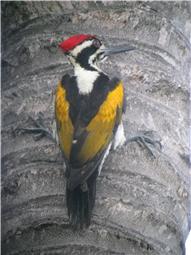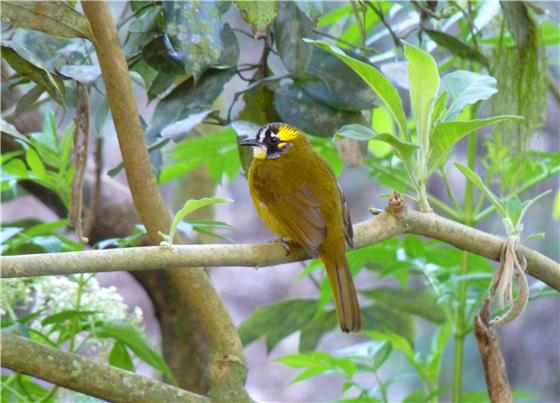The Biggest Twitch Sri Lanka Endemic Clean-up Tour
15 - 24 February 2011
Please note: We will be running tours in this wonderful country following the itinerary given below in February and March 2012. If you would like more details, just email us on
info@thebiggesttwitch.com.

No, not a farmyard rooster, this is Ceylon Junglefowl
If you’ve not birded in Asia before, Sri Lanka is the perfect introduction. You can enjoy all the excitement of discovering outstanding and vibrant Asian birds without the noise and bustle that may be slightly overwhelming in other countries if it’s your first visit to this part of the world.
If you’ve birded in other Asian countries before, Sri Lanka is still the perfect destination. You’ll find yourself birding in a mix of habitat ranging from dense forest to open wetland, beaches and tea plantations as you tick off one after another of the 25 endemic species.
If you add to the fabulous birds in interesting birding locations, the friendly people, good infrastructure, comfortable accommodation and delicious local food including the best rice and curry in the world, Sri Lanka really does have so much to offer.

Tranquil wetlands at Tissamaharama
Our birding started as soon as we left the airport, as we stopped on our journey to Kitulgala to get our eye in to the colour of Asian birding with the ubiquitous White-breasted Kingfisher and Blue-tailed Bee-eater. If our destination looked vaguely familiar, that’s because the Bridge over the River Kwai had been filmed here. Taking a dugout canoe rather than a bridge across the river, we entered the Kitulgala Forest Reserve and quickly added two of the most-prized endemics, Chestnut-backed Owlet and Spot-winged Thrush, to our rapidly growing list. Birding the trails as they wound through the forest the endemics just kept coming, including Ceylon Myna, and the enigmatic and recently discovered Serendib Scops-Owl, before the failing light meant we had to head back to our hotel.

Serendib Scops-Owl lurking at a daytime roost
We birded the forest again in the early morning cool the next day adding more amazing creatures in the form of Black-backed Kingfisher before we’d even crossed the river and endemic Layard’s Parakeet and Yellow-fronted Barbet in the tiny village on the other side. Plunging back into the forest, we birded all morning, enjoying a great array of new birds including a bristling pair of roosting Ceylon Frogmouths, the tricky-to-see Ceylon Spurfowl, Chestnut-headed Bee-eater and two more wonderful Serendib Scops-Owls at their day time roost.

Ceylon Frogmouths - a male and female sleeping in the jungle
Even in the shade of the forest, the midday temperatures rose and the birding slowed so we returned to our hotel for lunch and a chance to check our photos and relive the brilliant birds we had encountered. Once the hottest part of the day had passed, we headed out birding again, this time to the higher altitude and cooler air of the tea plantations. Still new birds came thick and fast including Ceylon Small Barbet hooting incessantly from a shade tree, a pair of Gray-rumped Treeswifts building their tiny cup-shaped nest out of spit and feathers, Jerdon’s Leafbird and White-browed Fantail.

Layard's Parakeet
Our next destination was the magical Sinharaja World Heritage Wilderness Area, with our accommodation, Blue Magpie Lodge, giving a clue as to one of the target birds here. Amongst the tea plantations outside the reserve we encountered White-browed Bulbuls passing through the shade trees, a Crested Serpent Eagle sat upon its nest, and Ceylon Small Barbet showed off for the camera. But it was inside the park once we’d picked up our reserve guide and 4x4 jeep that the birding really started to hot up. Catching up with a mixed feeding flock passing through the forest made for breathtaking birding as a riot of colour filtered through the trees.

Ceylon Blue Magpie
First up, Blue Magpie, an inquisitive, cobalt blue and brown bird with a long blue-and-white tail, a red bill and red bare skin around the eye and matching legs. Next our attention was caught by Crimson-backed Flameback, a dynamic endemic woodpecker, but soon a gang of the stunning Red-faced Malkoha, a charismatic, dark endemic with a bare red face, were vying for our attention.

Red-faced Malkoha
If all this colour was too much, we could rest our eyes on the more subtle hues of the skulking Scaly Thrush and Ceylon Crested Drongo, while a male Ceylon Junglefowl stalking haughtily across the path ahead of us looking for all the world like a farmyard rooster. As if this panoply of birds wasn’t enough, we also added reptiles such as Kangaroo Lizard and Green Forest Lizard to our list, and had a first-hand demonstration by one of the locals of how to collect palm juice for a heady home brew.
Moving on to the Udewalawa area, we had a complete change of scene as we birded the Udewalawa National Park in a more savanna-like habitat. Driving around the tracks in a 4x4 jeep, we regularly encountered family groups of wild elephants shading themselves under the trees while water buffalo lounged in muddy pools. From the elevated position of the jeep, we added good numbers of new birds to our list including Yellow-eyed Babblers, Blue-faced Malkoha, Sirkeer Malkoha, roosting Brown Fish Owl, and displaying Indian Peacocks. At the lunchtime picnic stop we explored on foot and caught up with a skulking Orange-headed Ground-Thrush and White-rumped Sharma, while tocque monkeys eyed up our picnic basket.

Asian Elephants in Udewalawa National Park
From here we moved on to the amazing wetland area at Tissamaharama, a wader-, waterbird- and wildfowl-lovers dream. Where to look first? On the extensive reservoir areas, fringed with reed and partly covered in lilypads and water hyacinth, were a myriad of birds. Yellow Bitterns skulked amongst the reeds, bizarre Pheasant-tailed Jacanas walked on water, Lesser Whistling-Ducks perched in a line on unsubmerged logs while Little and Great Cormorants spread themselves out to dry in the sun, Asian Openbills and Painted Storks stood on sentry duty while Eurasian Spoonbills scythed the water and Spot-billed Pelicans cruised by like galleons. Saunders, Common and Whiskered Terns circled and swooped, shorebirds including Lesser Sand Plover, Black-tailed Godwit and Common and Wood Sandpipers pottered in the shallows, while the local residents pedalled past on their bikes or puttered by in tuc-tucs, always friendly and interested but never pushy or intrusive. In the evening, we also visited what must be one of the best sites in the world to see and photograph Indian Pitta, as we found ourselves in a prime position between two obliging birds.

White-naped Woodpecker
An early morning start saw us lucky enough to catch up with the outstanding White-naped Woodpecker and a very close encounter with a Black Bittern. The best part of the day though was spent in Yala National Park, about which we’d heard so many positive tales. It didn’t disappoint. Driving around in our jeep, we encountered Malabar Pied Hornbill, Great Thick-knee and Barred Buttonquail, with many superb photo opportunities in this vast national park. Stretching our legs at a picnic point, we walked out onto the soft golden sands of the beach and scoped White-bellied Sea-Eagle. Bird of the day though was undoubtedly leopard, a magnificent male who showed off in full view as he sunned himself on a rock. The day wasn’t finished with us though as we spotlighted both Jerdon’s and Indian Little Nightjar on our way out of the park.

Sleepy male Leopard looks down from his lofty rock
We just had time to visit the saltpans the next day where we encountered masses of waders and terns including Little Pratincole, a gorgeous bird. The views of the birds here, in the morning sun, were wonderful. All too soon we headed off on the drive to Nuwara Eliya, a former hill station in the British colonial era, often referred to as ‘Little England’. The air was clear and fresh and the views breathtaking.
A very early start the next morning meant that we arrived at Horton Plains National Park before dawn and before the gate was due to open. But birding waits for no timetable and in the surprisingly chilly pre-dawn air we were fortunate to get good views of both Ceylon Whistling Thrush and Ceylon Bush Warbler around the entrance, before they melted away into the forest. Yellow-eared Babbler, Eurasian Blackbird, a potential split, very different from the European version, and Ceylon Wood Pigeon were also seen here. Entering the park, we drove through a bizarre landscape of tussocky grassland kept short by Sambar deer, while Pied Bushchat sat up on top of the larger bushes and as the temperatures rose, Hill Swallows swooped and dived all around us. Walking the trail out to the dramatic Mini and Great World’s End viewpoints on the edge of a sheer cliff gave us the chance to stretch our legs as well as proving good photo opportunities for Ceylon White-eye and Dull-blue Flycatcher, a far more colourful bird than its name suggests.

Dull-blue Flycatcher on the Horton Plains
Returning to Victoria Park, a very ‘English-feeling’ urban park of ornate flowerbeds, winding paths and ornamental trees, we were thrilled to get amazing views of the most-wanted male Pied Thrush as it crouched close to a stream, while a male Indian Blue Robin lurked nearby. There was just time to catch up with Kashmir Flycatcher in an area of dry woodland before we began the long drive back to Colombo via Kandy.

Pied Thrush at dawn
Having seen so many tea plantations and drunk so many cups of Ceylon tea during our stay, it was fascinating to visit a tea factory and see how it was made, but of course it was the incredibly close encounters with Hill Swallows that was the real reason for our stop here. We arrived back in Colombo early evening where our tour ended, with a full memory card in the camera and 240 species including all 25 endemics on our list.

Yellow-eared Bulbul
So would we recommend Sri Lanka? Without hesitation. The birds are fantastic, the locations stunning and varied, the country is safe, the infrastructure is good, the people are welcoming and friendly and the food is delicious. What more could you ask for? And would we go back there again? Definitely!
We will be running tours in this wonderful country following the itinerary below in February and March 2012. If you would like more details, just email us on
info@thebiggesttwitch.com.
Itinerary:
15 February Arrival in Colombo, Kitulgala
16 February Kitulgala
17 February Kitulgala, Sinharaja
18 February Sinharaja
19 February Sinharaja, Udawalawa
20 February Udawalawa, Tissamaharama
21 February Tissamaharama
22 February Tissamaharama, Nuwara Eliya
23 February Nuwara Eliya
24 February Nuwara Eliya, Kandy, Colombo – tour ends

Yellow-fronted Barbet